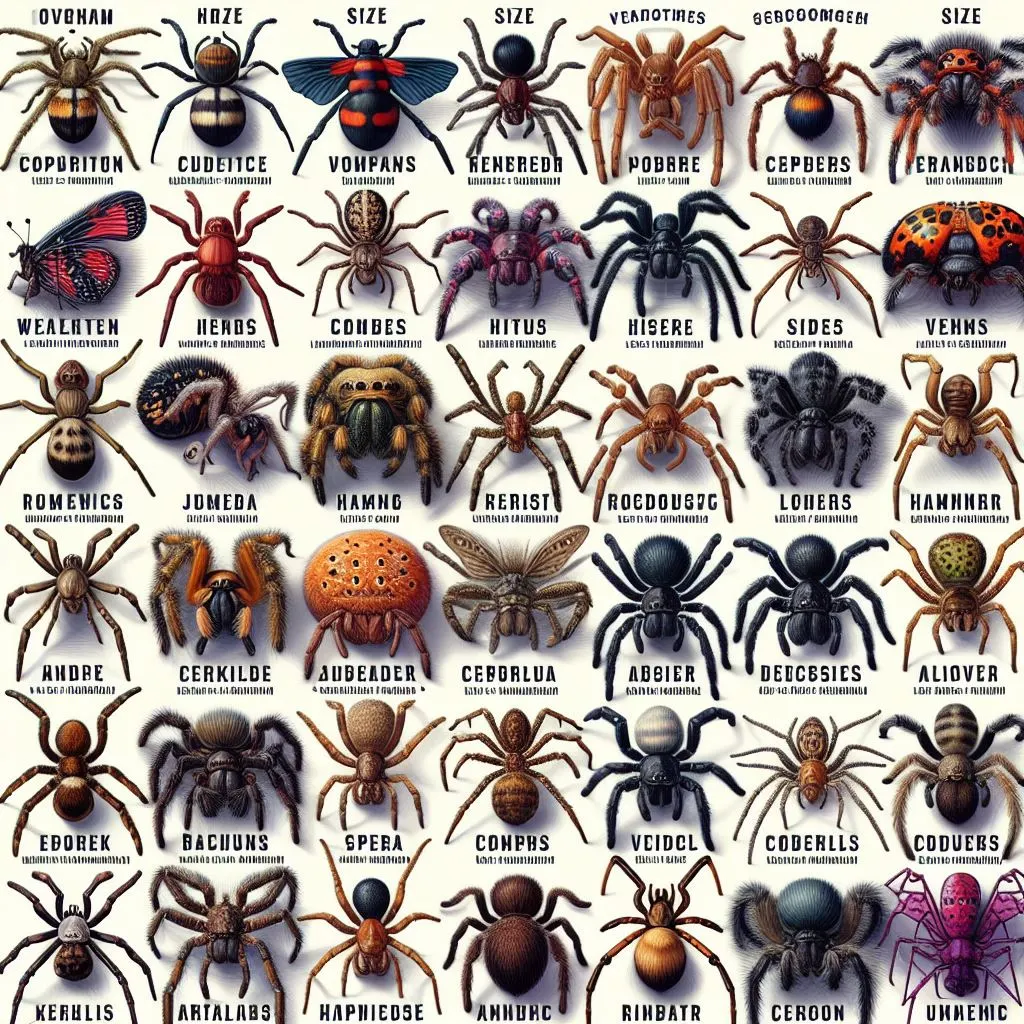Welcome, fellow arachnid enthusiasts, to a fascinating journey through the realm of the world’s most dangerous spiders! While spiders often evoke fear and dread in many people, they are an integral part of our ecosystem and deserve appreciation for their unique adaptations and behaviors. In this article, we’ll delve into the top 30 most dangerous spiders, exploring their habitats, venom potency, and the potential risks they pose to humans. So, grab your magnifying glass and let’s embark on this thrilling adventure!
30 most dangerous spiders
Brazilian Wandering Spider (Phoneutria spp.):
Our journey begins with the Brazilian Wandering Spider, known for its aggressive nature and potent venom. Found in South and Central America, these spiders are notorious for their deadly bite, which can cause severe pain, muscle paralysis, and even death if left untreated.
Sydney Funnel-web Spider (Atrax robustus):
Hailing from Australia, the Sydney Funnel-web Spider is one of the deadliest arachnids on the planet. With its large fangs and potent venom, a bite from this spider can result in rapid onset of symptoms, including difficulty breathing and muscle spasms, posing a significant threat to human life.
Black Widow Spider (Latrodectus spp.):
No list of dangerous spiders would be complete without the infamous Black Widow. Recognizable by its shiny black body and red hourglass marking, this spider’s venom contains neurotoxins that can cause intense pain, muscle cramps, and in severe cases, paralysis or death, particularly in young children and the elderly.
Brown Recluse Spider (Loxosceles reclusa):
Found primarily in the United States, the Brown Recluse Spider is known for its venomous bite, which can lead to necrotic lesions and tissue damage. While fatalities are rare, bites from this spider require prompt medical attention to prevent serious complications.
Six-eyed Sand Spider (Sicarius spp.):
Native to deserts in Africa and South America, the Six-eyed Sand Spider is a stealthy predator with potent venom. Despite its small size, this spider’s bite can cause tissue necrosis and systemic effects, making it a dangerous inhabitant of arid regions.
Redback Spider (Latrodectus hasseltii):
Similar in appearance to the Black Widow, the Redback Spider is found in Australia and is notorious for its venomous bite. Symptoms of envenomation include intense pain, sweating, and nausea, with severe cases requiring medical intervention to manage complications.
Chilean Recluse Spider (Loxosceles laeta):
As its name suggests, the Chilean Recluse Spider is native to Chile and other parts of South America. Its venom contains potent toxins that can lead to tissue necrosis and systemic effects, posing a significant health risk to humans.
Yellow Sac Spider (Cheiracanthium spp.):
Widespread in various parts of the world, including North America and Europe, the Yellow Sac Spider is known for its cytotoxic venom, which can cause localized pain, swelling, and tissue damage. While rarely fatal, its bite can lead to discomfort and medical complications in some cases.
Mouse Spider (Missulena spp.):
Found in Australia, the Mouse Spider is often mistaken for the Funnel-web Spider due to its similar appearance and habitat. While less aggressive than its notorious relative, a bite from this spider can still cause significant pain and discomfort, necessitating medical attention.
Brown Widow Spider (Latrodectus geometricus):
A close relative of the Black Widow, the Brown Widow Spider is widespread in tropical and subtropical regions around the world. While its venom is less potent than that of its counterpart, bites can still result in symptoms such as muscle cramps, nausea, and sweating.
Brazilian Wandering Spider (Phoneutria fera):
Another member of the Phoneutria genus, the Brazilian Wandering Spider is known for its aggressive behavior and potent venom. Found in South America, a bite from this spider can cause severe pain, respiratory distress, and in rare cases, death.
Sydney Funnel-web Spider (Hadronyche spp.):
In addition to the Atrax genus, several species of funnel-web spiders in the Hadronyche genus are native to Australia and possess potent venom. Bites from these spiders can result in rapid onset of symptoms, requiring immediate medical attention to prevent serious complications.
Widow Spiders (Latrodectus spp.):
Beyond the Black Widow and Redback, several other species in the Latrodectus genus are found across the globe, each with its own variation of potent venom. While fatalities are rare, bites from these spiders can cause intense pain and systemic effects, necessitating prompt medical care.
Recluse Spiders (Loxosceles spp.):
Alongside the Brown Recluse and Chilean Recluse, numerous other species in the Loxosceles genus are distributed worldwide. Their venomous bites can lead to tissue necrosis and systemic symptoms, highlighting the need for caution when encountering these spiders.
Wolf Spider (Lycosa spp.):
Despite their intimidating appearance, Wolf Spiders are generally not considered dangerous to humans. While their venom can cause localized pain and swelling, severe reactions are rare, and these spiders are valued for their role in controlling insect populations.
Australian Tarantulas (Selenocosmia spp.):
Native to Australia, various species of Australian Tarantulas are known for their large size and impressive hunting abilities. While their venom is not considered highly toxic to humans, bites can still cause localized pain and discomfort.
Funnel-web Spiders (Hexathelidae):
In addition to the Sydney Funnel-web Spider, several other species of funnel-web spiders belong to the Hexathelidae family, found predominantly in Australia. While their venom varies in potency, all members of this family should be treated with caution due to the potential for severe envenomation.
Fishing Spiders (Dolomedes spp.):
Named for their ability to hunt aquatic prey, Fishing Spiders are commonly found near bodies of water in various parts of the world. While their venom is not considered dangerous to humans, these spiders can deliver a painful bite if provoked.
Australian Funnel-web Spiders (Hadronyche spp.):
Alongside the Sydney Funnel-web Spider, several other species of funnel-web spiders in the Hadronyche genus inhabit Australia. While less well-known, these spiders possess potent venom and should be approached with caution to avoid bites.
Sac Spiders (Clubionidae):
Belonging to the Clubionidae family, Sac Spiders are distributed worldwide and are known for their distinctive silk retreats. While their venom is not considered medically significant, bites can cause localized pain and irritation.
Hobo Spider (Eratigena agrestis):
Originally from Europe, the Hobo Spider has become established in parts of North America, where it is sometimes considered a nuisance pest. While its venomous bite can cause localized necrosis in some cases, severe reactions are rare, and most bites resolve without complications.
Brazilian Wandering Spider (Phoneutria boliviensis):
Yet another member of the Phoneutria genus, the Brazilian Wandering Spider is found in various countries in South America. While its venom is highly potent, fatalities
Brazilian Wandering Spider (Phoneutria nigriventer):
Among the most venomous spiders in the world, the Phoneutria nigriventer, commonly known as the Brazilian Wandering Spider, is notorious for its aggressive behavior and potent neurotoxic venom. Found in the rainforests of South America, a bite from this spider can lead to severe symptoms such as paralysis, respiratory distress, and in extreme cases, death.
Brazilian Wandering Spider (Phoneutria keyserlingi):
Another member of the Phoneutria genus, the Phoneutria keyserlingi, inhabits regions of South America, including Brazil and Argentina. With venom capable of causing intense pain, muscle spasms, and systemic effects, encounters with this spider should be approached with caution to avoid potentially dangerous bites.
Brown Widow Spider (Latrodectus geometricus):
Distinct from its more infamous relatives, the Brown Widow Spider is found in various tropical and subtropical regions worldwide. While its venom is less potent than that of the Black Widow, bites from this spider can still result in symptoms such as muscle cramps, nausea, and localized pain.
Funnel-web Spiders (Agelenidae):
Beyond the Australian funnel-web spiders, numerous species within the Agelenidae family are found across the globe. While their venom is generally not considered dangerous to humans, bites can cause localized pain and irritation, highlighting the importance of cautious behavior around these spiders.
Mouse Spiders (Missulena spp.):
In addition to the Mouse Spider species found in Australia, several other species within the Missulena genus inhabit various regions of the world. While bites from these spiders can cause significant pain and discomfort, fatalities are rare, and most cases can be managed with prompt medical attention.
Brazilian Wandering Spider (Phoneutria bahiensis):
One more member of the Phoneutria genus, the Phoneutria bahiensis, is found in parts of South America, including Brazil and Venezuela. With venom capable of causing severe neurotoxic effects, encounters with this spider pose a considerable risk to human health and safety.
Australian Tarantulas (Selenotholus spp.):
Alongside the Selenocosmia genus, various species of Australian Tarantulas belong to the Selenotholus genus, found primarily in the arid regions of Australia. While their venom is not considered highly toxic to humans, bites can cause localized pain and discomfort, necessitating caution when handling these spiders.
Brazilian Wandering Spider (Phoneutria pertyi):
The Phoneutria pertyi, commonly known as the Brazilian Wandering Spider, is native to regions of South America, including Brazil and Paraguay. With venom capable of causing severe neurotoxic effects, encounters with this spider should be avoided whenever possible to prevent potentially life-threatening bites.
Conclusion:
As we conclude our exploration of the top 30 most dangerous spiders in the world, it’s essential to recognize the importance of understanding and respecting these fascinating creatures. While spiders may evoke fear in many people, they play a crucial role in maintaining ecological balance and controlling insect populations. By learning more about the behaviors and habitats of these spiders, we can coexist with them safely and appreciate the intricate beauty of the natural world. So, the next time you encounter a spider, remember to treat it with caution and admiration for its remarkable adaptations and contributions to our ecosystem.

